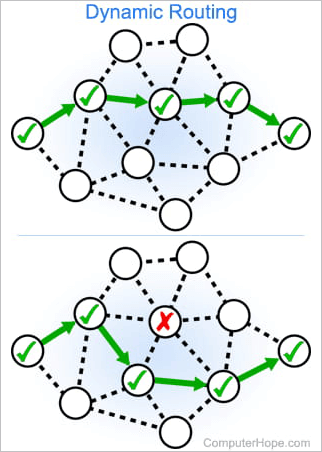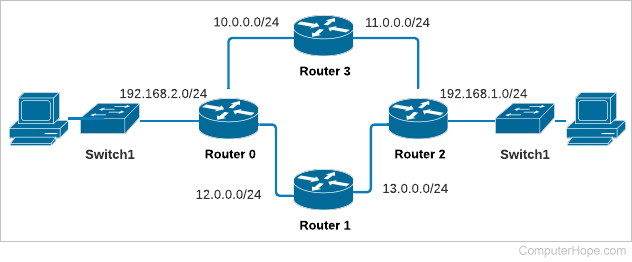Dynamic routing

Dynamic routing is a technique for finding the optimal path for data on a computer network.
Dynamic routers can select paths for data packets based on information about the current status of the network. If one network section fails or experiences traffic congestion, data can be re-routed to circumvent that part of the network in real-time.
Dynamic routers communicate using a dynamic routing protocol to share information about the network status. They use the shared information to update their routing table, a set of rules determining where network traffic should be directed.
The ability to adapt to a changing network topology is the key benefit of dynamic routing.
History
Dynamic routing was first used in computer networking in 1980. The first routing protocol was RIP (Routing Information Protocol), and version 1 of the protocol, RIPv1, was released in 1988.
Since then, many new protocols have emerged. RIPv1 was updated in version 2 of the protocol, RIPv2, but it was still limited in its ability to manage larger networks. The OSPF (Open Shortest Path First) networking protocol was developed to handle these more complex networks.
Purpose of dynamic routing
Protocols related to routing share details among different routers. Dynamic routing combines processes, algorithms, and messages that convey network status and best-path information.
The purposes of a dynamic protocol are:
- Explore network topologies, both known and unknown.
- Exchange information with other dynamic routers about network status and topology.
- Update routing tables based on exchanged information.
- Select the optimal way to access destination networks.
- Seek a new best route if the previously-calculated route is unavailable.
Dynamic routing components
There are three main components of a dynamic routing protocol.
Data structure
In a dynamic routing protocol, information is structured in a table format, like a spreadsheet. The table contains an up-to-date set of rules for how to transmit data.
Algorithm
Dynamic routing algorithms perform many important functions, such as determining how the routing table should be updated. For example, an algorithm may try to find the current route with the smallest "cost" based on the status of the network. The "cost" is a combination of factors that might interfere with fast network performance, such as latency, available bandwidth, or the geographical distance between nodes.
Routing protocol messages
The protocol also transmits various operational messages to explore networks and share information.
Protocols for dynamic routing
The most widely-used dynamic routing protocols are OSPF (Open Shortest Path First) and RIP (Routing Information Protocol).
OSPF (Open Shortest Path First)
Open Shortest Path First is a dynamic routing protocol for wide-area IP (Internet Protocol) networks. This protocol uses a database of connection data to collect network information as a graph. It evaluates the most efficient path based on available paths and their current link state. It structures network data in segments to optimize the total size of the link-state database.
OSPF is more efficient than RIP when a status change is found in the network.
RIP (Routing Information Protocol)
RIPv2 (Routing Information Protocol version 2) is an obsolete routing protocol. Designed for a comparatively low hop count of 15, RIPv2 is prone to scalability problems and performs poorly on larger, more complex networks.
In RIPv2, path analysis of modern networks may require merging multiple results, which increases the time to identify the best paths.
Workings of dynamic routing
For organizations with complex networks, optimizing routing costs is critical. Dynamic routing offers the best data transfer routes, better maintenance tools, and a more flexible configuration process.
The operations of the dynamic protocol may be generalized as follows:
- Routing messages on router interfaces are sent and accepted by the router.
- Routing information, details, and messages are sent to other routers using the same protocol.
- Routers share routing information with remote networks.
- Whenever a router finds a topology change, it is communicated to other routers using the protocol.

Dynamic routing on wide networks is easier to customize and more intuitive as you pick the right path. It also facilitates the detection of shifts in routes and the exploration of current networks. However, when routers share updates, they use more bandwidth than static routing. As a result, routers, CPUs (central processing unit), and RAM (random-access memory) have to deal with extra loads. Therefore, dynamic routing requires more powerful hardware and may require a higher level of maintenance than static routing configurations.
Advantages of dynamic routing
Dynamic routing protocols have the following advantages:
- They allow routing information to be shared if topology changes occur in the network.
- As the routes are not manually programmed, the configuration is more flexible to modify.
- It is less error-prone than static routing.
- Its performance benefits scale well on complex networks with many nodes.
Dynamic, Internet protocol, Network card, Network terms, OSPF, RIP, Routing, Static
